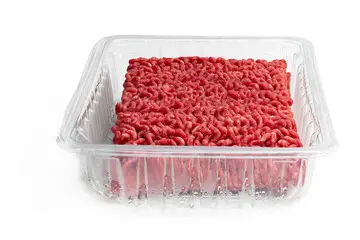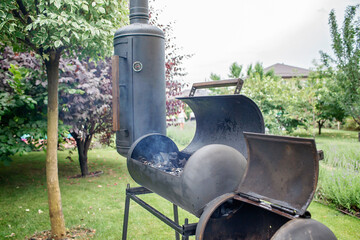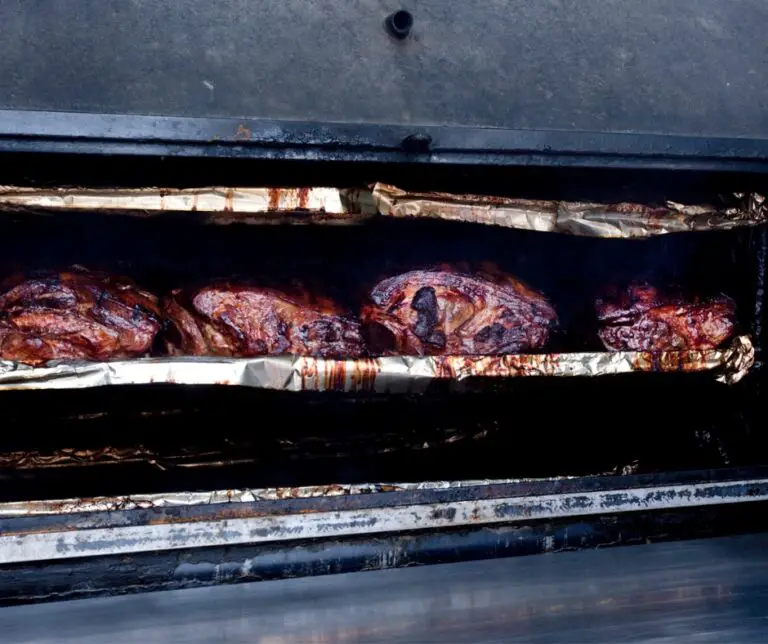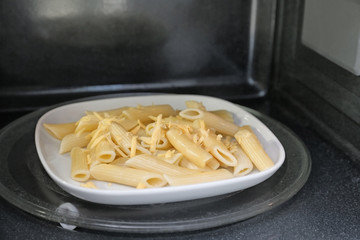
Cooking pasta in the microwave is convenient because it is a quick and easy way to prepare a meal. Simply combine the pasta and water in a microwave-safe bowl, microwave according to package instructions or until al dente, and drain. This process can be completed in just a few minutes, making it a great option for a last-minute dinner or a quick lunch at work.
It is important to note that there may be some potential texture differences when cooking pasta in the microwave compared to stovetop cooking. Pasta cooked in the microwave may not have the same texture as pasta cooked in a pot of boiling water on the stove. The pasta may be softer and less firm, and it may not hold its shape as well. However, the convenience of microwave cooking may outweigh any potential texture differences for some people.
How to Cook Pasta in The Microwave?
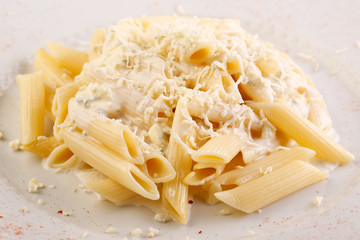
Step 1: Gather your ingredients and other supplies
To cook pasta in the microwave, you will need to gather the following ingredients and supplies:
- Microwave-safe bowl: You will need a bowl that is large enough to hold the pasta and water, and that is safe for use in the microwave. Avoid using bowls made of metal or anything with a metallic finish, as these materials can cause sparks in the microwave.
- Fork: You will need a fork to stir the pasta as it cooks in the microwave.
- Pasta: Any type of pasta will work for microwave cooking. Just be sure to follow the package instructions for cooking times and water ratios if they are different from the general guidelines.
- Water: You will need water to cook the pasta in the microwave. The general rule of thumb is to use 2 cups of water for every 1 cup of pasta, but you may need to adjust this ratio depending on the type and shape of pasta you are using.
Step 2: Measure out the pasta:
When cooking pasta in the microwave, it is important to use the correct amount of water to ensure that the pasta cooks properly. The general rule of thumb is to use 1½ cups of water for every 1 cup of pasta. However, you may need to adjust this ratio depending on the type and shape of pasta you are using.
For example, pasta shapes with more surface area (such as spaghetti or linguine) will require more water than shapes with less surface area (such as elbow macaroni or penne). Similarly, thicker pasta shapes (such as fettuccine or pappardelle) will require more water than thin pasta shapes (such as angel hair or vermicelli).
It is also important to adjust the water-to-pasta ratio based on the type of pasta you are using. For example, whole wheat pasta or pasta made from other alternative grains may require more water than traditional white pasta.
To ensure that your pasta cooks properly in the microwave, it is best to follow the package instructions for the specific type and shape of pasta you are using. These instructions will provide the recommended water-to-pasta ratio and cooking time. If you are using a type of pasta that does not have specific instructions, you can use the general 2 cups of water to 1 cup of pasta ratio as a guide, but be prepared to adjust it as needed.
Step 3: Combine the pasta and water in a microwave-safe bowl:
To cook pasta in the microwave, you will need to combine the pasta and water in a microwave-safe bowl. It is important to fully submerge the pasta in the water to ensure that it cooks evenly and properly. If the pasta is not fully submerged, it may not cook evenly, resulting in some parts being undercooked and others being overcooked.
To fully submerge the pasta in the water, you may need to use a larger bowl or a deeper container than you would when cooking on the stove. This will allow you to add enough water to fully cover the pasta.
Once you have combined the pasta and water in the microwave-safe bowl, use a fork to stir the pasta to ensure that it is evenly coated in water. This will help to prevent the pasta from sticking together as it cooks.
After you have combined the pasta and water and stirred it well, you are ready to microwave the pasta according to the package instructions or until it is al dente (tender but still firm). This will typically take between 6 and 8 minutes, depending on the type and shape of pasta.
Step 4: Microwave the pasta:
Once you have combined the pasta and water in a microwave-safe bowl and stirred it well, you are ready to microwave the pasta. To do this, simply place the bowl in the microwave and cook the pasta according to the package instructions, or until it is al dente (tender but still firm).
If you are using a type of pasta that does not have specific microwave cooking instructions, the general rule of thumb is to microwave the pasta for 6-8 minutes, depending on the type and shape. Thicker pasta shapes (such as fettuccine or pappardelle) may require closer to 8 minutes of cook time, while thin pasta shapes (such as angel hair or vermicelli) may only need 6 minutes.
It is important to check the pasta frequently during the cooking process to ensure that it is cooking evenly and to prevent it from becoming overcooked. You can do this by using a fork to gently stir the pasta and test a piece for doneness. When the pasta is al dente, it should be tender but still have a firm bite.
Once the pasta is cooked to your desired level of doneness, carefully remove the bowl from the microwave and proceed to the next step, which is draining the pasta.
Step 5: Drain the pasta:
After the pasta has finished cooking in the microwave, it is important to drain it properly to remove any excess water. To do this, carefully remove the bowl from the microwave, as it will be hot.
You can then use a colander or a slotted spoon to drain the pasta. If you are using a colander, simply place it in the sink and pour the pasta and water into the colander. The water will drain through the holes, while the pasta will remain in the colander. If you are using a slotted spoon, you can use it to scoop the pasta out of the bowl and into a separate container, leaving the water behind.
Once the pasta has been drained, you can add your desired sauce and any additional toppings. Then, you are ready to serve and enjoy your microwave-cooked pasta.
Step 6: Serve the pasta:
To serve the pasta, simply add your desired sauce and any additional toppings to the drained pasta. Some popular options include tomato sauce, Alfredo sauce, pesto, or olive oil and garlic. You can also add toppings such as grated cheese, herbs, or vegetables.
Once the pasta has been dressed with sauce and toppings, you are ready to serve and enjoy it. You can portion out the pasta onto individual plates or serve it family-style in a large bowl.
FAQs
Is it safe to microwave-cooked pasta?
Yes, it is safe to microwave-cooked pasta. In fact, microwaving is a quick and easy way to reheat leftover pasta or to cook pasta from scratch if you don’t have access to a stove.
What happens if you microwave dry pasta?
If you try to microwave dry pasta, it will not cook properly and may become overcooked or burnt. This is because microwaves work by heating water molecules, and dry pasta does not contain enough moisture to cook properly in the microwave.
Why is microwaved pasta better?
Microwaved pasta may be considered “better” by some people because it is a quick and convenient way to cook or reheat pasta. It is especially useful for those who are short on time or who don’t have access to a stove.
Does microwaved pasta taste good?
Whether microwaved pasta tastes good or not is a matter of personal preference. Some people may prefer the texture of pasta that has been cooked on the stove, while others may find microwaved pasta to be just as satisfactory. It is worth noting that microwaved pasta may not have the same texture as pasta cooked on the stove, and it may be softer and less firm. However, the convenience of microwave cooking may outweigh any potential texture differences for some people.
Finally
In conclusion, cooking pasta in the microwave is a convenient and simple way to prepare a quick and easy meal. It is a great option for those who are short on time or don’t have access to a stove. While there may be some potential texture differences compared to stovetop cooking, the convenience of microwave cooking may outweigh any such differences for some people. Whether you are looking for a quick lunch or a last-minute dinner solution, cooking pasta in the microwave is definitely worth a try.

Hi, I’m Iolanda I am a mother of two and know how to whip up satisfying dishes for friends and family in a seemingly effortless way. The blog goal is reader-oriented, So We are always looking for the newest information about the best products on the market to offer product reviews and tutorials to assist users.Have Fun on The Website


